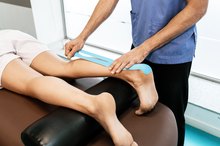Tendons in the Back of Knee
Your knees help support your body and allow your legs to bend and straighten, providing the foundation for you to walk, run, jump and turn. On the back of your thighs are the hamstring muscles, and at the bottom of those muscles are the tendons that cross the back of the knee joint, connecting the muscle to the tibia, a bone below the knee.
When the tendons are in good shape, there's no need to think about them very much. When they're strained or torn, however, they can really wreak havoc on not only your workout or athletic performance, but also on your everyday life.
Read more: Exercises for Hamstring Tendonitis
Potential Injuries
Although hamstring strains seemingly refer to the muscle itself, it typically refers to how the muscle interacts with the tendon. Muscle strains often occur where the muscle meets the tendon, though it can also happen in the thick middle part of the muscle. In the worst-case scenario, the hamstring tendon tears completely away from the tibial bone
In a less severe — though still debilitating — concern, hamstring tendinopathy occurs when the tendons are irritated or the tendon degenerates. Because the tendon is thick, fibrous and has poor blood supply, the area is slow to heal. Despite the location of the injury, you're more likely to feel pain radiating up the back of your thigh or deep in your glutes.
Tears, strains and tendinopathy can happen to anyone; however, it's more likely in football, basketball and soccer players, runners, dancers and both older athletes and adolescents. A lack of or an insufficient warm-up, repetitive motions and overtraining all contribute to these injuries.
- Although hamstring strains seemingly refer to the muscle itself, it typically refers to how the muscle interacts with the tendon.
- In the worst-case scenario, the hamstring tendon tears completely away from the tibial bone In a less severe — though still debilitating — concern, hamstring tendinopathy occurs when the tendons are irritated or the tendon degenerates.
Strengthening the Tendons
Chair Exercises to Strengthen Legs
Learn More
Generally speaking, any exercise that strengthens the hamstring muscles will also strengthen its tendons. Start with mild stretches and exercises. If you've been severely injured, begin exercising only with the OK of a medical professional and, ideally, under the supervision of a physical therapist.
When you're ready to do heavier movements or you're doing exercises to prevent injury, options include:
Read more: Exercises for High Hamstring Tendinopathy
- Generally speaking, any exercise that strengthens the hamstring muscles will also strengthen its tendons.
Related Articles
References
- American Academy of Orthopaedic Surgeons: Hamstring Muscle Injuries
- eOrthopod: ACL Hamstring Tendon Graft Reconstruction
- Sports Injury Clinic: Hamstring Strain Strengthening Exercises
- Physio-Pedia: Hamstring Origin Tendinopathy
- Ernlund L, Vieira LA. Hamstring injuries: update article. Rev Bras Ortop. 2017;52(4):373-382. doi:10.1016/j.rboe.2017.05.005
- Heiderscheit BC, Sherry MA, Silder A, Chumanov ES, Thelen DG. Hamstring strain injuries: recommendations for diagnosis, rehabilitation, and injury prevention. J Orthop Sports Phys Ther. 2010;40(2):67-81. doi:10.2519/jospt.2010.3047
- Moatshe G, Chahla J, Vap AR, et al. Repair of Proximal Hamstring Tears: A Surgical Technique. Arthrosc Tech. 2017;6(2):e311-e317. doi:10.1016/j.eats.2016.10.004
- Noonan TJ, Garrett WE. Muscle strain injury: diagnosis and treatment. J Am Acad Ortho Surg. Jul 1999;7:262-9.
Writer Bio
M. Gideon Hoyle is a writer living outside of Houston. Previously, he produced brochures and a wide variety of other materials for a nonprofit educational foundation. He now specializes in topics related to health, exercise and nutrition, publishing for various websites.







